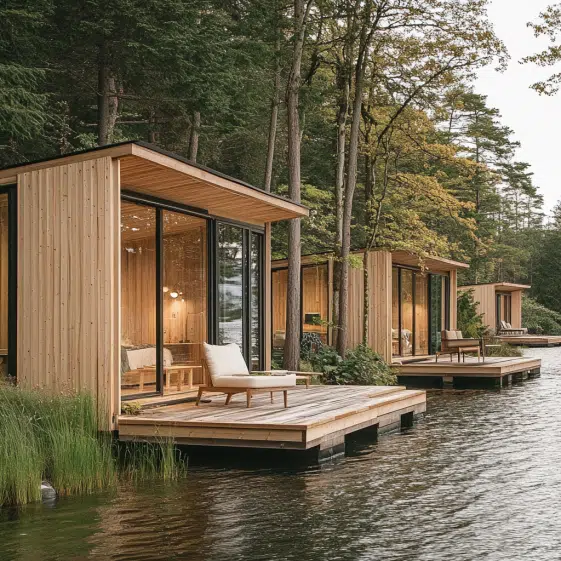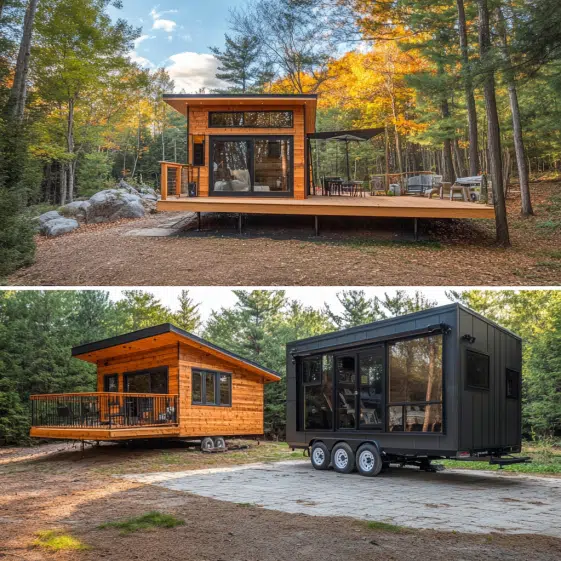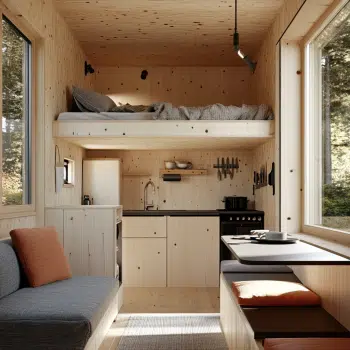Mini Cabins
Compact, Stylish, and Functional Living Spaces
Mini Cabins: Why These Small Homes Are Gaining Popularity
The appeal of mini cabins has been growing steadily as more people look for affordable, minimalist, and sustainable living solutions. These compact homes offer a unique blend of functionality and charm, making them a popular choice for those who want to downsize, embrace nature, or create a peaceful retreat. Whether used as full-time residences, vacation getaways, or remote workspaces, mini cabins provide a practical alternative to traditional housing while promoting a simpler way of life.
One of the main reasons mini cabins are becoming more popular is their affordability. Compared to traditional homes, these smaller structures require fewer materials and less labor to construct, significantly reducing costs. Many people find that investing in a mini cabin allows them to achieve homeownership without the burden of a long-term mortgage. Additionally, lower utility expenses and maintenance costs make these homes an attractive option for individuals looking to reduce their financial obligations while still enjoying a comfortable living space. Discover the charm of compact living with our Tiny House with Loft. Perfect for a minimalist lifestyle. Explore more about the Tiny House with Loft

Another factor contributing to the rise of mini cabins is their versatility. These homes can be built in various styles and sizes, making them suitable for different purposes. Some people choose to use mini cabins as permanent residences, while others prefer them as vacation homes or guest houses. The ability to customize layouts and features ensures that these compact spaces can be adapted to meet specific needs, whether for a single occupant or a small family. Many homeowners also use them as rental properties, taking advantage of the growing demand for unique and eco-friendly accommodations.
Sustainability is another key reason why mini cabins are gaining popularity. Many of these homes are designed with energy efficiency in mind, using eco-friendly materials and sustainable building techniques. With a smaller footprint, they require less energy to heat and cool, reducing overall environmental impact. Many mini cabins also incorporate off-grid living solutions such as solar panels, rainwater collection systems, and composting toilets, making them ideal for those seeking a self-sufficient lifestyle. This focus on sustainability aligns with the increasing awareness of environmental conservation and the desire to live more responsibly. Maximize your space with our stylish Tiny House Stairs. Designed for both functionality and elegance. Learn more about our Tiny House Stairs
The appeal of mini cabins is also tied to the growing trend of minimalist living. Many people are drawn to the idea of decluttering their lives and focusing on experiences rather than material possessions. A mini cabin encourages a simpler way of life by offering only the essential living space needed, without unnecessary excess. This shift toward minimalism allows homeowners to prioritize quality over quantity, making room for meaningful activities, travel, and personal fulfillment.
The ability to place mini cabins in scenic and remote locations is another reason they are becoming so popular. Whether nestled in the woods, by a lake, or on a mountainside, these cabins provide a peaceful escape from the stress of urban life. Their compact size allows them to be placed on small plots of land, making it easier for people to own property in desirable locations without the high costs associated with larger homes. This flexibility appeals to outdoor enthusiasts, remote workers, and anyone looking for a serene retreat.
With affordability, sustainability, versatility, and a focus on minimalism, mini cabins have become a sought-after housing solution. As more people seek alternatives to traditional homes, the appeal of these small yet functional living spaces continues to grow. Whether used for everyday living or as a weekend escape, mini cabins offer a practical and stylish way to embrace a simpler, more intentional lifestyle. Make your tiny home cozy with our space-saving Tini house sofá. Perfect for comfort and style
How to Design Mini Cabins for Maximum Comfort and Efficiency
Designing mini cabins requires thoughtful planning to make the most of limited space while ensuring a comfortable and functional living environment. These compact homes have become increasingly popular for those seeking a minimalist, eco-friendly lifestyle, but maximizing both comfort and efficiency is essential to fully enjoy small-space living. With the right approach to layout, furniture, lighting, and energy use, mini cabins can feel spacious, inviting, and highly functional.
One of the most important aspects of designing mini cabins is choosing the right layout. Since space is limited, an open floor plan can create a sense of openness while maintaining a natural flow between different areas. Avoiding unnecessary walls and using multifunctional zones allows the space to feel larger than it actually is. Lofted sleeping areas are a common solution to free up valuable floor space, leaving room for a comfortable living area and kitchen below. Well-placed windows also enhance the layout by bringing in natural light, making the interior feel bright and airy. Enhance your outdoor space with a charming Tiny House Garden Shed. Ideal for storage and style. Explore our Tini house garden shed options today!
Furniture selection plays a key role in optimizing both comfort and efficiency in mini cabins. Since every inch matters, choosing pieces that serve multiple purposes is essential. Foldable or extendable tables, sofas that double as beds, and built-in storage benches help maximize functionality without adding clutter. Wall-mounted shelves and hooks take advantage of vertical space, providing extra storage while keeping the floor area clear. Compact kitchen appliances and slim-profile furniture allow for an efficient setup without sacrificing usability.
Lighting is another crucial element in designing mini cabins for maximum comfort. Natural light is an effective way to make small spaces feel larger, so incorporating large windows or skylights helps open up the space. Light-colored walls and reflective surfaces further enhance brightness, creating an inviting atmosphere. For nighttime lighting, a combination of overhead lights, wall sconces, and task lighting ensures that the space remains functional and cozy. Warm, dimmable LED lights contribute to a comfortable ambiance while also being energy-efficient.

Energy efficiency is a key consideration when designing mini cabins, especially for those looking to live sustainably. Many small homes are built with eco-friendly materials and insulation to maintain comfortable indoor temperatures while minimizing energy use. Solar panels can be integrated to provide renewable energy, reducing reliance on traditional power sources. Energy-efficient appliances, such as low-consumption refrigerators and induction cooktops, help conserve electricity without compromising functionality. Heating and cooling systems, such as wood stoves or mini-split units, can be selected based on the climate and energy needs of the cabin.
Storage solutions are essential for maintaining a clutter-free and efficient living space in mini cabins. Utilizing hidden storage under furniture, in staircases, or within built-in cabinets helps keep belongings organized. Multipurpose storage solutions, such as fold-out desks or modular shelving, allow homeowners to customize their space according to their needs. A well-organized cabin enhances daily comfort by reducing clutter and creating a more relaxing environment.
By carefully planning the layout, selecting versatile furniture, maximizing natural light, and prioritizing energy efficiency, mini cabins can be both comfortable and highly functional. With the right design choices, these small homes offer an efficient way to live without sacrificing style or convenience. Whether used as a full-time residence, a vacation retreat, or an off-grid escape, a well-designed mini cabin provides a cozy and sustainable way to enjoy small-space living. Stay warm and cozy with our efficient Tiny Home Wood Stove. Perfect for compact living. Check out our Tiny House Wood stove
Mini Cabins vs. Traditional Tiny Homes: Which One is Right for You?
Deciding between mini cabins and traditional tiny homes is an important choice for those looking to embrace small-space living. While both offer a compact, minimalist lifestyle, there are key differences that may influence which option is the best fit. Factors such as design, mobility, cost, and sustainability all play a role in determining whether mini cabins or traditional tiny homes align better with an individual’s lifestyle and needs.
One of the main differences between mini cabins and traditional tiny homes is their construction and design. Mini cabins typically feature a more rustic and nature-inspired aesthetic, often built with wood or other natural materials. They are commonly used as weekend retreats, off-grid getaways, or secondary living spaces on a larger property. Traditional tiny homes, on the other hand, tend to resemble smaller versions of standard houses. They often incorporate modern design elements, including sleek exteriors, contemporary interiors, and high-efficiency appliances. Those who prefer a rustic, nature-inspired atmosphere may lean toward mini cabins, while those seeking a home with a modern feel may find traditional tiny homes more appealing. Experience the freedom of mobile living with our Tiny Home RV. Perfect for travel and comfort. Explore our Tiny Home RV

Mobility is another significant factor when choosing between mini cabins and traditional tiny homes. Many tiny homes are built on trailers, allowing for easy relocation and offering a flexible lifestyle for those who want to travel or move frequently. They are often designed with lightweight materials and compact layouts to make transportation easier. In contrast, mini cabins are usually built on a foundation, making them more permanent structures. While they can be moved if necessary, they are not designed for frequent relocation. Those looking for a mobile lifestyle may find a tiny home on wheels more suitable, while those wanting a stationary retreat or long-term residence may prefer mini cabins.
Cost is another key consideration in deciding between mini cabins and traditional tiny homes. Mini cabins can often be more affordable to build or purchase, especially when constructed with locally sourced materials or repurposed resources. Their simple designs and minimalistic approach help keep costs low. Traditional tiny homes, particularly those with high-end finishes and modern amenities, can be more expensive due to their customized construction. While both options are generally more affordable than conventional houses, mini cabins may provide a lower-cost alternative for those looking to build on a budget.
Sustainability is another important aspect to consider when comparing mini cabins to traditional tiny homes. Both options promote eco-friendly living by reducing the amount of energy, water, and materials needed compared to standard homes. However, mini cabins often take sustainability a step further by incorporating off-grid features such as solar panels, rainwater collection systems, and wood-burning stoves. While traditional tiny homes can also include these elements, they are often built with convenience and modern living in mind, which may result in higher energy consumption depending on the appliances and systems used. Those prioritizing off-grid, eco-conscious living may find mini cabins to be a better fit.
Choosing between mini cabins and traditional tiny homes depends on personal preferences, lifestyle goals, and budget. Mini cabins offer a rustic, stationary, and often more budget-friendly option, while traditional tiny homes provide modern amenities and greater mobility. Understanding these differences helps in making the right decision, ensuring that small-space living meets both practical and personal needs. Explore the convenience and quality of Prefabricated Tiny Houses. Built for efficiency and style. Learn more about our Prefabricated Tiny Houses.
Sustainability and Off-Grid Living in Mini Cabins
The growing interest in sustainable living has made mini cabins a popular choice for those looking to reduce their environmental impact while embracing a simpler lifestyle. These compact homes require fewer resources to build and maintain, making them an eco-friendly alternative to traditional housing. For those seeking independence from municipal utilities, mini cabins also provide an excellent foundation for off-grid living. With the right design and features, these small homes can offer both comfort and self-sufficiency in a way that supports a greener way of life.
One of the key aspects of sustainability in mini cabins is their efficient use of space and materials. Unlike conventional homes that often result in significant material waste, these small structures are built with minimal resources, reducing the environmental footprint. Many mini cabins incorporate recycled or reclaimed wood, energy-efficient insulation, and non-toxic finishes, further promoting sustainable construction. The reduced size of these homes also means less energy is needed for heating and cooling, making them naturally more energy-efficient.
Heating and cooling systems in mini cabins can also be designed with sustainability in mind. Wood stoves are a common choice for heating, as they provide warmth using a renewable resource. Many cabins also incorporate passive solar heating, using well-placed windows to maximize natural heat from the sun. Proper insulation and ventilation help maintain comfortable indoor temperatures without excessive energy use. For cooling, strategically placed windows and energy-efficient fans allow for natural airflow, reducing the need for air conditioning.
Living off-grid in mini cabins encourages a minimalist and self-sufficient lifestyle. With limited space, residents become more conscious of their energy and resource consumption, making sustainable choices a daily habit. Growing food through small-scale gardening, using natural materials for construction, and relying on renewable energy all contribute to a more eco-friendly way of living.

As more people seek alternatives to traditional housing, mini cabins provide a practical and sustainable solution. By integrating energy-efficient features, water-saving systems, and renewable energy sources, these small homes offer a way to live comfortably while reducing environmental impact. Whether as a full-time residence or a remote retreat, mini cabins are a step toward a greener and more independent. See also Home
We invite you to visit 1A Group, a page full of amazing Artificial Intelligence tools designed to make your life easier and enhance your projects. Additionally, you will find interesting and up-to-date information on a wide variety of topics of interest.
